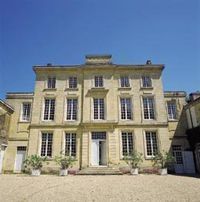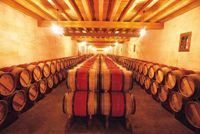 | Figeac continues to be the largest estate in the commune of Saint-Emilion, with 40 hectares of vines. The central part of the chateau, built in a very pure, classical architectural style, dates from the late 18th century. Although most of the appellation is planted with Merlot (which is ideal for limestone soils), and to a lesser extent Cabernet Franc, Chateau Figeac uses completely different proportions of grape varieties on account of its fine gravelly soil: 70 % Cabernet (half Cabernet Franc, half Cabernet Sauvignon) and only 30 % Merlot. This unusual blend of grape varieties explains why Figeac can be considered the "most Médoc of Saint-Emilions". |
| The grand vin then goes into new oak for up to 20 months, whereas second year barrels are used for the second wine. At the required time the wine is fed to the bottling line in the underground cellar, excavated in 1971, by a gentle gravity feed. The grand vin is Chateau Figeac and the second wine is La Grange Neuve de Figeac. The wines of Chateau Figeac are frequently noteworthy, not least for their striking red and yellow label designed by Robert Villepigue in the early 20th century. But it is the wine inside the bottle that matters most, of course, and fortunately here it frequently meets with expectations. |  |